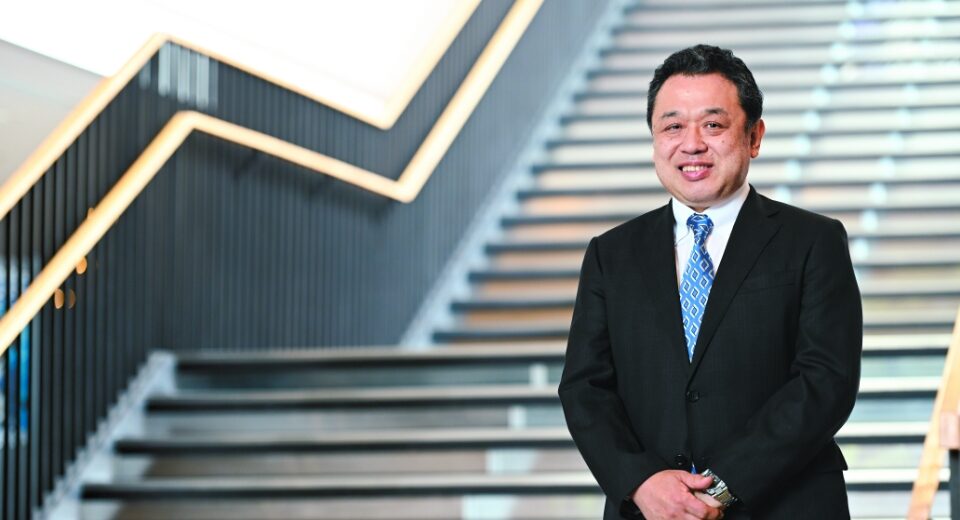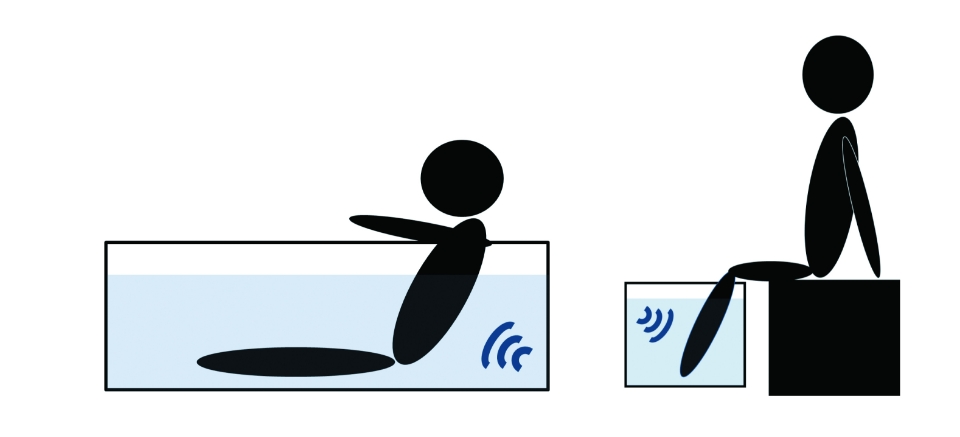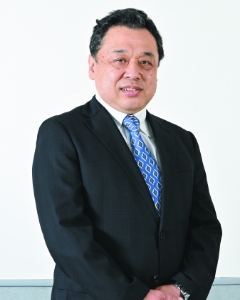Interview with researchers 13
Prevention of aging-related illnesses
via low intensity ultrasound irradiation

- Interview Hiroshi Ichikawa
- Professor,
Faculty of Life and Medical Sciences,
Department of Medical Life Systems
Determining the sources of diseases, and an optimal balance between active oxygen and antioxidant potential are key to maintaining good health
Like all living organisms, human beings undergo changes constantly throughout their lives. Once physical growth ceases and an individual transitions from the period of maturity, subsequent changes are a part of “aging.” No individual can avoid the phenomenon of aging, and active oxygen is thought to be deeply involved in this process. The overproduction of active oxygen due to an extreme lack of exercise, psychological burden, smoking, and other factors, destroys the balance between active oxygen within an organism and its antioxidant potential, that is, the ability of internal antioxidants to eliminate active oxygen. This state is known as antioxidative stress, and if this stress continues to be elevated, it can trigger diabetes and several other diseases.
Professor Hiroshi Ichikawa, who studies oxidative stress, states, “We used to think that active oxygen itself is a cause of physical damage and sought to eliminate active oxygen. However, we found that simply removing active oxygen led to the failure of the body to fight internal oxidation adequately (we call this the ‘antioxidant potential’). Thus, to maintain the balance between active oxygen and antioxidant potential, it is important to raise the levels of antioxidant potential.” Dr. Ichikawa evaluates antioxidant potential by assessing the body’s ability to remove six types of active oxygen. For this purpose, he utilizes a method known as “electron paramagnetic resonance (EPR) spin trapping.” Through this approach, Dr. Ichikawa found that depending on the disease and physical condition, the pattern of antioxidant potential differs for each active oxygen type. He believes that these differences can be used for disease diagnosis and prevention.
Dr. Ichikawa also explained his concept of evaluating blood samples for changes in the antioxidant potential for the six types of active oxygen, resulting from the consumption of foods with potential health benefits (so-called “functional foods”). Based on such results, a physician can prescribe functional foods that are beneficial for each type of illness.
Dr. Ichikawa kickstarted his career as a clinical doctor. While working as a gastroenterologist, primarily in hospitals in the Kyoto Prefecture, he also conducted research on oxidative stress at a research laboratory. Since 2003, his key priority was preventative medicine, in particular, nutritional science. He also got involved in the education and training of managerial dieticians. “In my clinical work during the influenza epidemic of the 1998/99 season, I felt strongly about the importance of daily diet. I recognized the differences in symptoms between those who ate properly and those who did not. Ever since then, I have studied the relationships between oxidative stress and diet, with a focus on functional foods. Clinical medicine is certainly fascinating, as it gives you the chance to meet individually with each patient. Yet, the number of lives one can positively save is limited. I would like to save as many lives as possible, through the fruition of my research work,” he explains.
Confirming that ultrasonic radiation improves antioxidant potential to the same extent as physical exercise
Surprisingly, it is not widely known that active oxygen produced by muscles is involved in the health-maintenance effects of exercise. A minute amount of active oxygen is generated whenever an organism is physically stimulated, even slightly. This triggers an adaptive reaction designed to overcome that stimulus. The special focus of Dr. Ichikawa’s research in recent years involves the use of this reaction, specifically “the improvement of antioxidant potential by means of ultrasound radiation.” He hypothesized that equivalent effects as those from physical exercise can be obtained when stimulation occurs via ultrasound radiation in lieu of exercise. Dr. Ichikawa has been conducting experiments on rats to study optimal ultrasound intensities for irradiation of an organism (Figure. 1). Based on blood tests performed on day eight of the experiment, he found that antioxidant potential improved when a rat was irradiated with a safe dose of ultrasound, once every two days. This result demonstrates that ultrasound radiation performed at low intensities might generate the same effects as that of exercise.

Next, using nematodes—standard model organisms used for aging research—Dr. Ichikawa tested the effects of ultrasound irradiation on longevity. When low intensity ultrasound irradiation was conducted for one minute, three times a week, experimental results revealed an extension of the nematode lifespan. Dr. Ichikawa used a further approach to verify the effects of ultrasound irradiation on strengthening antioxidant potential. Here, tumor necrosis factor-α (TNF-α), a cytokine that promotes muscle atrophy, is added to a culture medium, in which the skeletal muscle cells of a mouse undergo ultrasound irradiation. He then found that muscle atrophy due to TNF-α was suppressed by the ultrasound irradiation. He adds, “Ultrasound irradiation may help to prevent sarcopenia, an oxidative stress-related disease that causes reduced muscle mass and decreased muscle strength. We think that this finding may contribute to an extension of healthy life expectancy, especially important in Japan with its aging population.”
Dr. Ichikawa aims to develop this health-management method by means of ultrasound irradiation for human applications. He notes, “This method is not limited to sarcopenia and aging. It includes all oxidative stress-related diseases, including diabetes, dementia, and more. Since this method uses irradiation at low intensities, within established safety standards, its safety is assured. This is a positive aspect when considering its potential applications.”
Since ultrasound irradiation devices are already used for a variety of applications, Dr. Ichikawa says that once optimal irradiation conditions are determined for humans, the development of dedicated devices can quickly get underway. A wide range of users are anticipated, from aged persons to athletes, to the hospitalized and patients living at home. These devices will be extremely useful and practical, in that they could be used at hospitals, training facilities, and in private homes. Dr. Ichikawa says, “Our next step is to collect fundamental data on humans, to determine optimal irradiation conditions. We also plan to earnestly perform research toward practical uses, including ascertaining the effects of irradiation at different body sites. We are collaborating with companies, including for the development of irradiation devices that can be used at home. We plan to move forward closely together with our collaborators” (Figure. 2).

Elucidating tolerance induction mechanisms for oxidative stress aimed toward order-made diagnostics and treatments
Dr. Ichikawa will refer to Japanese standards for food safety for his further research on improving sperm function. He mentions, “Among all cells in the body, sperm cells have the most sensitive reactions to oxidative stress. Currently, no objective data exists regarding the benefits of antioxidant materials in infertility treatment, so we are still working to gather related findings.” Male impotence is triggered by a decline in sperm function, as seen in oligospermia (low sperm count) and asthenospermia (a condition where sperm have difficulty moving or swimming properly). Based on the results from animal experiments, Dr. Ichikawa has determined that an antioxidant known as S-allyl cysteine (SAC) improves sperm function. SAC is a functional component present in garlic and since it has been confirmed to be as safe as essential amino acids, long-term consumption is possible. He is now exploring collaborations with private companies for the development of related medicines and functional foods.
Dr. Ichikawa serves as the Director of the Doshisha University Research Center for Cell Protection and Regeneration Systems. This post enables him to enjoy exchanges with scholars and researchers from a wide variety of disciplines. His Center collaborates with researchers outside of Doshisha University and performs joint research with private companies to determine clinical applications for its research findings.
In the future, Dr. Ichikawa hoped to provide order-made diagnostics personalized to each patient’s antioxidant potential, which is measured during an examination, much like how blood pressure is measured for medical examinations and treatments. With this as his aim, he is concentrating on elucidating the mechanisms that induce tolerance for antioxidative stress within an organism, by accumulating more data.
Once this is achieved, he has plans for clinical trials for patients in rehabilitation for sarcopenia, stroke, and more, to benefit from the practical use of ultrasound irradiation. “Making marketable products is not our only aim. Basic knowledge surrounding ultrasound technology needs to be provided to hospitalized patients and people at clinical sites. Since the procedure will be ready at hand, it will make it error prone. We are actively striving to overcome, one by one, the hurdles toward real applications,” he concludes. Thus, Dr. Ichikawa will continue to confront his field’s challenges as he seeks to make major contributions in broad fields, for the maintenance of human health.

